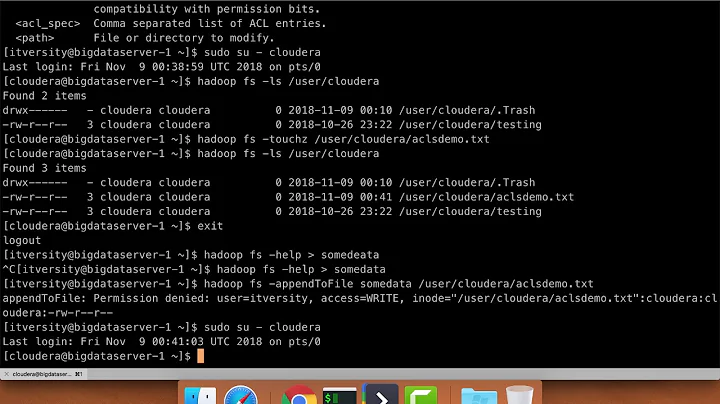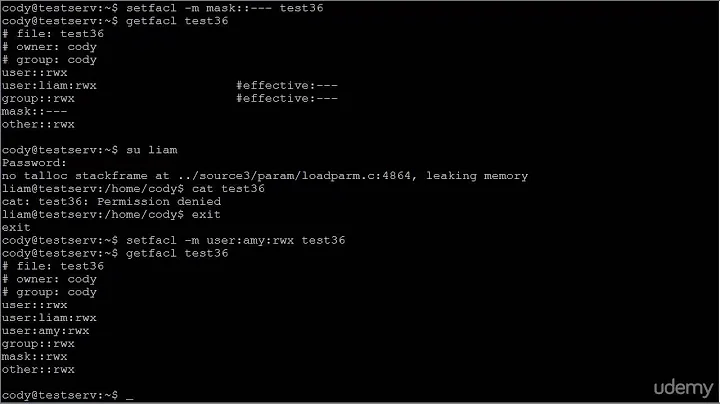Setting differing ACLs on directories and files
Solution 1
As Gilles points out, setfacl default permissions specify the maximum permissions, basically replacing the umask. So newly created files will be rw unless the application that created the file asked specially for it to be executable.
$ mkdir test
$ touch test/oldfile
$ getfacl test/oldfile
# file: test/oldfile
# owner: myuser
# group: myuser
user::rw-
group::r--
other::r--
$ setfacl -m d:g:mygroup:rwx test
$ touch test/newfile
$ getfacl test/newfile
# file: test/newfile
# owner: myuser
# group: myuser
user::rw-
group::r-x #effective:r--
group:mygroup:rwx #effective:rw-
mask::rw-
other::r--
Note the effective perms above. (There are only a few programs that will ask to set the execute bit on files that it creates, e.g. gcc for executables and cp if the file being copied was executable.)
Or did you mean that the first setfacl command was working the way you wanted, but the second one wasn't? In other words, you're looking to fix up permissions on the old files, making sure that directories are traversable, without giving other regular files execute permissions?
My version of setfacl allows X exactly like you want, e.g.:
setfacl g:mygroup:rwX
$ setfacl --version
setfacl 2.2.49
$ rm -r test
$ mkdir test
$ mkdir test/olddir
$ touch test/oldfile
$ find test -ls
107513 4 drwxr-xr-x 3 myuser myuser 4096 Dec 22 01:56 test
107539 0 -rw-r--r-- 1 myuser myuser 0 Dec 22 01:56 test/oldfile
107529 4 drwxr-xr-x 2 myuser myuser 4096 Dec 22 01:56 test/olddir
$ setfacl -Rm g:somegroup:rwx test
$ find test -ls
107513 4 drwxrwxr-x 3 myuser myuser 4096 Dec 22 01:56 test
107539 0 -rw-rwxr-- 1 myuser myuser 0 Dec 22 01:56 test/oldfile
107529 4 drwxrwxr-x 2 myuser myuser 4096 Dec 22 01:56 test/olddir
$ rm -r test
$ mkdir test
$ mkdir test/olddir
$ touch test/oldfile
$ setfacl -Rm g:somegroup:rwX test
$ find test -ls
107513 4 drwxrwxr-x 3 myuser myuser 4096 Dec 22 01:56 test
107539 0 -rw-rw-r-- 1 myuser myuser 0 Dec 22 01:56 test/oldfile
107529 4 drwxrwxr-x 2 myuser myuser 4096 Dec 22 01:56 test/olddir
If your version of setfacl doesn't support that, why not use find?
overwrite permissions, setting them to rw for files and rwx for dirs
$ find . \( -type f -exec setfacl -m g:mygroup:rw '{}' ';' \) \
-o \( -type d -exec setfacl -m g:mygroup:rwx '{}' ';' \)
set mygroup ACL permissions based on existing group permissions
$ find . \( -perm -g+x -exec setfacl -m g:mygroup:rw '{}' ';' \) \
-o \( -exec setfacl -m g:mygroup:rwx '{}' ';' \)
You'll probably want to check that the group mask provides effective permissions. If not, you'll have to run this too:
$ find . -type d -exec chmod g+rwX '{}' ';'
Solution 2
For future readers, to use setfacl on existing files/folders without adding the executable bit to your files, the solution is this part of @Mikel's answer:
My version of setfacl allows X exactly like you want, e.g.:
setfacl g:mygroup:rwX
Relevant excerpt from the setfacl documentation:
The perms field is a combination of characters that indicate the permissions: read (r), write (w), execute (x), execute only if the file is a directory or already has execute permission for some user (X).
Solution 3
As far as I understand Linux ACLs, setfacl -Rdm g:mygroup:rwx share_name does exactly what you want. Experiment:
umask 007
mkdir foo
chgrp mygroup foo
chmod 2700 foo
setfacl -d -m group:mygroup:rwx foo
setfacl -m group:mygroup:rwx foo
touch foo/data
echo '#!/bin/ls' >foo/exec
chmod +x foo/exec
Then as a different user in group mygroup:
$ cat foo/*
#!/bin/ls
#!/bin/ls
$ ./foo/data
ash: ./foo/data: Permission denied
$ ./foo/exec
./foo/exec
What's going on?
$ getfacl foo/data
# file: foo/data
# owner: myuser
# group: mygroup
user::rw-
group::---
group:mygroup:rwx #effective:rw-
mask::rw-
other::---
The effective ACL for mygroup is the result of and'ing the ACL_GROUP entry for mygroup (rwx) with the ACL_MASK entry (rw-).
The acl(5) man page explains calculation this under “Access check algorithms”. It doesn't explain how ACL_MASK entries are generated, but in practice the right thing seems to happen.
Related videos on Youtube
Jay Desai
Updated on September 17, 2022Comments
-
Jay Desai over 1 year
I want to set up default permissions for a file share so that everyone can
rwxall of the directories and so that all newly created files arerw.Everyone who is accessing this share is in the same group, so this isn't a concern.
I have looked at doing this via ACLs without changing all of the users' umasks and such. Here are my current invocations:
setfacl -Rdm g:mygroup:rwx share_name setfacl -Rm g:mygroup:rwx share_nameMy problem is that while I want all of the newly created sub-directories to be
rwx, I only want newly created files to berw.Does anyone have a better method to achieve my desired end-result? Is there some way to set ACLs on directories separately from files, in a similar vein to
chmod +xvs.chmod +X?Thanks




